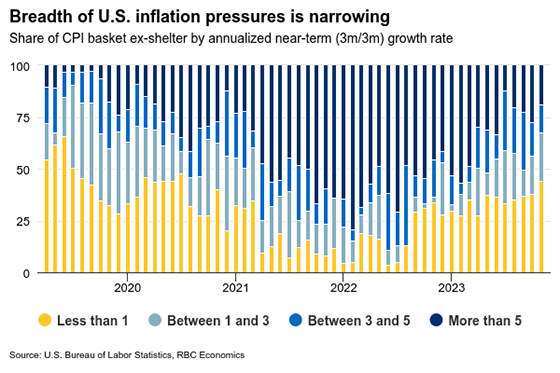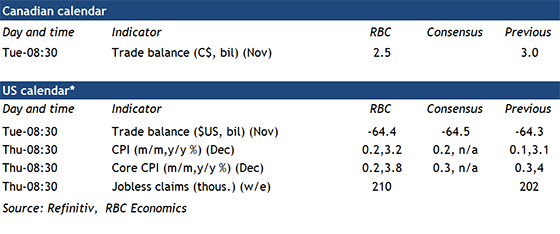U.S. inflation numbers will be front and center for the Fed as discussions among policymakers shift from how high to push interest rates to when the first cuts might be appropriate.
We look for U.S. CPI growth to show further signs of moderation in December, notwithstanding a likely tick higher in the year-over-year rate of headline price growth to 3.2% from 3.1% a month earlier. That small increase should be entirely explained by a smaller year-over-year decline in energy prices – gasoline prices were little changed in December from November (on a seasonally adjusted basis) but a large monthly decline a year ago will fall out of the year-over-year calculation.
Food price growth likely continued to edge lower and we look for signs of a narrowing breadth of remaining inflation pressures in recent months to persist. We expect year-over-year price growth in core (excluding food and energy) products to slow to 3.8% from 4.0% on a more ‘normal’ looking 0.2% monthly (seasonally adjusted) increase from November. Home rent price growth is accounting for a disproportionate share of gains in core prices – roughly 70% of the year-over-year increase as of November by our count – and will continue to slow as moderation in growth in market rents passes through with a lag as leases are renewed. Excluding shelter costs, the share of goods and services in the U.S. CPI basket seeing inflation at above a 3% rate shrunk to 32% over the three months to November – a share broadly in line with pre-pandemic levels.
The Fed remains focused on getting inflation under control but sent a clear message in December that rate cuts are also coming into view. Indeed, with price growth trending in the right direction and signs that economic growth is slowing, the Fed is widely expected to pivot to interest rate cuts in the first half of this year. Our own forecast assuming the first decrease comes in Q2.
Week ahead data watch
We expect the Canadian trade surplus to shrink to $2.5 billion in November after ballooning to $3 billion in October. A 10% drop in oil prices in November will have lowered the value of exports more than imports.















